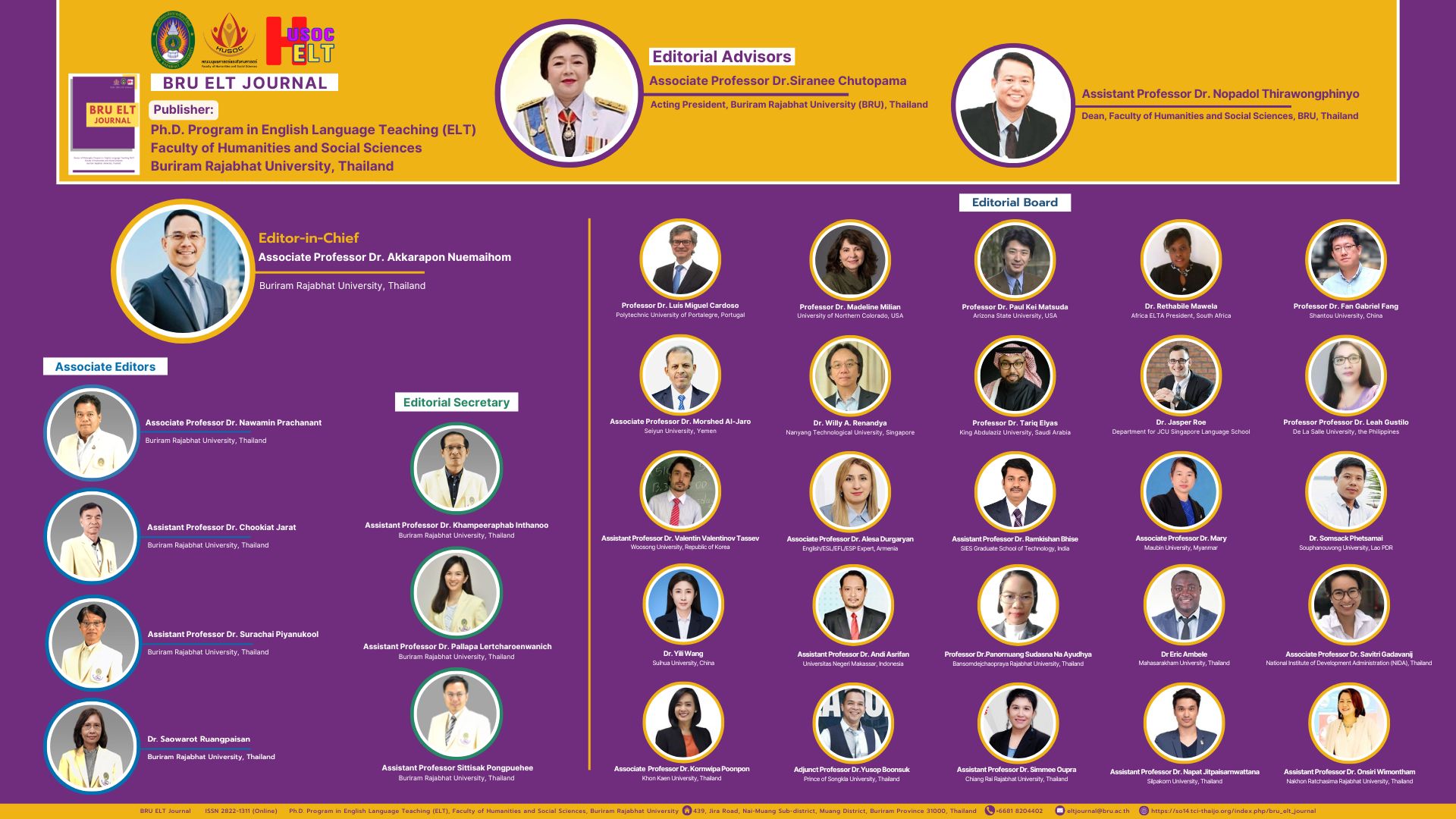Conceptualization of (Im) politeness of Burmese and Rakhine Native Speakers in Myanmar
DOI:
https://doi.org/10.14456/bej.2024.2Keywords:
politeness, impoliteness, Burmese, Rakhine, theoretical/folk-theoretic conceptualizationsAbstract
The terms "politeness" and "impoliteness" are defined in various ways by different scholars in the field of pragmatics. According to scholars of the discursive approach to politeness, those phenomena mainly differ on the point of actual participants and cultures. This study aimed to investigate the notions of politeness and impoliteness in the conceptualization of speakers of the Burmese and Rakhine languages of Myanmar within the framework of Theoretical/folk-theoretic conceptualizations (second order) by Kadar and Haugh (2013) is the theoretical standpoint of the current research. The qualitative research method was used to find out the required data. Data obtained from the interview of five participants from each ethnic group were analyzed with the help of the discourse analysis method. The most significant finding of this study is the tentative definitions of politeness and impoliteness of Burmese and Rakhine native speakers. In addition, commonalities and differences between the conceptualization of politeness in Rakhine and Burmese were also investigated. Hopefully, this present study will contribute to understanding politeness and impoliteness across cultures by providing universal and culturally distinctive components of (im)politeness in Myanmar.
References
Aydınoğlu, N. (2013). Politeness and impoliteness strategies: An analysis of gender differences in Geralynl. Horton’s plays. Procedia -Social and Behavioral Sciences, 83, 473-482. https://doi.org/10.1016/j.sbspro.2013.06.093
Brown, P., & Levinson, S. (1978). Universals in language usage: Politeness phenomena. In E. Goody (Ed.), Questions and politeness: Strategies in social interaction (pp. 56-310). Cambridge University Press.
Brown, P., & Levinson, S. C. (1987). Politeness: Some universals in language usage (Vol. Series Number 4). https://doi.org/10.1604/9780521313551
Campbell, L., Lee, N. H., Okura, E., Simpson, S., & Ueki, K. (2017). The Catalogue of endangered languages (ElCat). http://endangeredlanguages.com/userquery/download/
Chang, C. B. (2003). High-interest loans: The phonology of English loanword adaptation in Burmese (B.A.thesis). Harvard University.
Croft, W., & Cruse, D. A. (2004). Cognitive linguistics. Cambridge University Press. http://dx.doi.org/10.1017/CBO9780511803864
Culpeper, J. (2005). Impoliteness and entertainment in the television quiz show: The weakest link. Journal of Politeness Research. Language, Behaviour, Culture, 1(1). https://doi.org/10.1515/jplr.2005.1.1.35
Culpeper, J., O’Driscoll, J., & Hardaker, C. (2019). "Notions of politeness in Britain and North American" From speech acts to lay understandings of politeness. In E. Ogiermann & P. B. Garces-Conejos (Eds.), Multilingual and multicultural perspectives (pp.177-200). Cambridge University Press.
Davis, H. A. (2014). Consonant correspondences of Burmese, Rakhine and Marma with initial implications for historical relationships (Publication No. 1640) [Master’s thesis, University of North Dokota]. https://commons.und.edu/theses/1640
Delve. Ho, L., & Limpaecher, A. (2023, November 1). What is discourse analysis? An introduction & guide. Delvetool. https://delvetool.com/blog/discourse-analysis
Department of Population, Ministry of Labour, Immigration and Population. (2014). Census atlas MYANMAR: The 2014 Myanmar population and housing census.
Eelen, G. (2001). A critique of politeness theories. St. Jerome Publishing.
Fraser, B., & Nolen, W. (1981). The association of deference with linguistic form. International Journal of the Sociology of Language, 1981(27). https://doi.org/10.1515/ijsl.1981.27.93
Fukushima, S., & Sifianou, M. (2017). Conceptualizing politeness in Japanese and Greek. Intercultural Pragmatics, 14(4). https://doi.org/10.1515/ip-2017-0024
Haugh, M. (2004). Revisiting the conceptualisation of politeness in English and Japanese. Multilingua - Journal of Cross-Cultural and Interlanguage Communication, 23(1-2), 85-109. https://doi.org/10.1515/mult.2004.009
Hodeib, C. (2022). A multi-perspective analysis of politeness in Syrian Arabic (PhD Dissertation). https://dea.lib.unideb.hu/bitstreams/6b7d41cb-6391-440d-a797-378b01eb1d3e/download
Kádár, D. Z. (2017, March 29). Politeness in pragmatics. Oxford Research Encyclopedia.
Kádár, D. Z., & Haugh, M. (2014). Understanding politeness. https://doi.org/10.1017/CBO9781139382717
Kasper, G. (1990). Linguistic politeness: Current research issues. Journal of Pragmatics, 14, 193-218. http://dx.doi.org/10.1016/0378-2166(90)90080-W
Kerkam, Z. M. (2015). A comparison of Arabic and English directness and indirectness: Cross-cultural politeness (PhD Dissertation). https://core.ac.uk/download/pdf/154423992.pdf
Lakoff, R. (1973). The logic of politeness: Or, minding your p’s and q’s. In C. Corum, T. Cedric Smith-Stark, & A. Weiser (Eds.), Papers from the 9th regional meeting of the Chicago linguistic society. Chicago Linguistic Society, 292-305.
Leech, G. (2014). The Pragmatics of politeness. Oxford University Press.
Leech, G. N. (1983). Principles of pragmatics. Longman. https://doi.org//10.1604/9780582551107
Lin, T. (2013). The concepts of "Politeness": A comparative study in Chinese and Japanese verbal communication. Intercultural Communication Studies,
Locher, M. A. (2006). Polite behavior within relational work: The discursive approach to politeness. Multilingua, 25(3), 249-267. https://doi.org/10.1515/multi.2006.015
Mills, S. (2005). Gender and impoliteness. Journal of Politeness Research. Language, Behaviour, Culture, 1(2), 263-280. https://doi.org/10.1515/jplr.2005.1.2.263
Mills, S., & Grainger, K. (2016). Directness and indirectness across cultures. https://doi.org/10.1057/9781137340399
Min, S. (2021). Conceptualizing politeness in Korean and English. Modern Studies in English Language & Literature, 65(4), 197-217. https://doi.org/10.17754/mesk.65.4.197
Ogiermann, E., & Saloustrou, V. (2020). Conceptualizing politeness in Greek and Great Britain. Glossologia, 28, 1-25.
Ogiermann, E., & Suszczynsk, M. (2011). On im/politeness behind the iron curtain. In F. Bargiela & D. Z. Kadar (Eds.), Politeness across cultures (pp.194-215). Palgrave Macmillan.
Same traditional customs of the ethnicities. (1975). Printing and Publication Enterprise.
Sifianou, M. (2015). Conceptualizing politeness in Greek: Evidence from twitter corpora. Journal of Pragmatics, 86, 25-30. https://doi.org/10.1016/j.pragma.2015.05.019
Sifianou, M., & Tzanne, A. (2010). Conceptualizations of politeness and impoliteness in Greek. Intercultural Pragmatics, 7(4). https://doi.org/10.1515/iprg.2010.029
Thomas, J. A. (1995). Meaning in interaction: An introduction to Pragmatics. Routledge.
Tin, H. (2000). Myanmar education: Status, issues, and challenges. Journal of South Asian Education, 1(1), 134-162.
Watts, R. J. (2003). Politeness. Cambridge University Press. https://doi.org/10.1604/978521794060
Watts, R. J., Ide, S., & Ehlich, K. (Eds.). (2005). Politeness in language: Studies in Its history, theory and practice. Monton de Gruyter. XXII (2), 151-165.
Wun, U. (1958, February). The Burmese language. The Altantic. https://www.theatlantic.com/magazine/archive/1958/02/the-burmese-language/306831/






